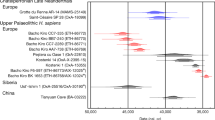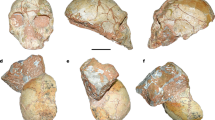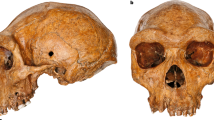Abstract
The hominin record from southern Asia for the early Late Pleistocene epoch is scarce. Well-dated and well-preserved fossils older than ∼45,000 years that can be unequivocally attributed to Homo sapiens are lacking1,2,3,4. Here we present evidence from the newly excavated Fuyan Cave in Daoxian (southern China). This site has provided 47 human teeth dated to more than 80,000 years old, and with an inferred maximum age of 120,000 years. The morphological and metric assessment of this sample supports its unequivocal assignment to H. sapiens. The Daoxian sample is more derived than any other anatomically modern humans, resembling middle-to-late Late Pleistocene specimens and even contemporary humans. Our study shows that fully modern morphologies were present in southern China 30,000–70,000 years earlier than in the Levant and Europe5,6,7. Our data fill a chronological and geographical gap that is relevant for understanding when H. sapiens first appeared in southern Asia. The Daoxian teeth also support the hypothesis that during the same period, southern China was inhabited by more derived populations than central and northern China. This evidence is important for the study of dispersal routes of modern humans. Finally, our results are relevant to exploring the reasons for the relatively late entry of H. sapiens into Europe. Some studies have investigated how the competition with H. sapiens may have caused Neanderthals’ extinction (see ref. 8 and references therein). Notably, although fully modern humans were already present in southern China at least as early as ∼80,000 years ago, there is no evidence that they entered Europe before ∼45,000 years ago. This could indicate that H. neanderthalensis was indeed an additional ecological barrier for modern humans, who could only enter Europe when the demise of Neanderthals had already started.
This is a preview of subscription content, access via your institution
Access options
Subscribe to this journal
Receive 51 print issues and online access
$199.00 per year
only $3.90 per issue
Buy this article
- Purchase on Springer Link
- Instant access to full article PDF
Prices may be subject to local taxes which are calculated during checkout



Similar content being viewed by others
References
Dennell, R. Early Homo sapiens in China. Nature 468, 512–513 (2010)
Dennell, R. in Southern Asia, Austalia and the Search for Human Origins (eds Dennell, R. & Porr, M. ) 33–50 (Cambridge Univ. Press, 2014)
Storm, P. et al. U-series and radiocarbon analyses of human and faunal remains from Wajak, Indonesia. J. Hum. Evol. 64, 356–365 (2013)
Barker, G. et al. The ‘human revolution’ in lowland tropical Southeast Asia: the antiquity and behavior of anatomically modern humans at Niah Cave (Sarawak, Borneo). J. Hum. Evol. 52, 243–261 (2007)
Hershkovitz, I. et al. Levantine cranium from Manot Cave (Israel) foreshadows the first European modern humans. Nature 520, 216–219 (2015)
Grine, F. E. et al. Late Pleistocene human skull from Hofmeyr, South Africa, and modern human origins. Science 315, 226–229 (2007)
Benazzi, S. et al. The makers of the Protoaurignacian and implications for Neandertal extinction. Science 348, 793–796 (2015)
Villa, P. & Roebroeks, W. Neandertal demise: an archaeological analysis of the modern human superiority complex. PLoS ONE 9, e96424 (2014)
Cheng, H. et al. Improvements in 230Th dating, 230Th and 234U half-life values, and U–Th isotopic measurements by multi-collector inductively coupled plasma mass spectometry. Earth Planet. Sci. Lett. 371–372, 82–91 (2013)
Xing, S., Martinón-Torres, M., Bermúdez de Castro, J. M., Wu, X. & Liu, W. Hominin teeth from the early Late Pleistocene site of Xujiayao, Northern China. Am. J. Phys. Anthropol. 156, 224–240 (2015)
Bailey, S. E. A morphometric analysis of maxillary molar crowns of Middle-Late Pleistocene hominins. J. Hum. Evol. 47, 183–198 (2004)
Xing, S. et al. Middle Pleistocene hominin teeth from Longtan Cave, Hexian, China. PLoS ONE 9, 3114265 (2014)
Kaifu, Y. Advanced dental reduction in Javanese Homo erectus. Anthropol. Sci. 114, 35–43 (2006)
Kaifu, Y. et al. Taxonomic affinities and evolutionary history of the early Pleistocene hominids of Java: dentognathic evidence. Am. J. Phys. Anthropol. 128, 709–726 (2005)
Gómez-Robles, A. et al. Geometric morphometric analysis of the crown morphology of the lower first premolar of hominins, with special attention to Pleistocene Homo. J. Hum. Evol. 55, 627–638 (2008)
Bailey, S. E. Neandertal Dental Morphology: Implications for Modern Human Origins. PhD thesis, Arizona State Univ. (2002)
Martinón-Torres, M., Bermúdez de Castro, J. M., Gómez-Robles, A., Prado-Simón, L. & Arsuaga, J. L. Morphological description and comparison of the dental remains from Atapuerca-Sima de los Huesos site (Spain). J. Hum. Evol. 62, 7–58 (2012)
Martinón-Torres, M. et al. Dental evidence on the hominin dispersals during the Pleistocene. Proc. Natl Acad. Sci. USA 104, 13279–13282 (2007)
Shang, H. & Trinkaus, E. The Early Modern Human from Tianyuan Cave, China (Texas A&M Univ. Press, 2010)
Bowler, J. M. et al. New ages for human occupation and climatic change at Lake Mungo, Australia. Nature 421, 837–840 (2003)
Mellars, P. Why did modern human populations disperse from Africa ca. 60,000 years ago? A new model. Proc. Natl Acad. Sci. USA 103, 9381–9386 (2006)
Oppenheimer, S. The great arc of dispersal of modern humans: Africa to Australia. Quat. Int. 202, 2–13 (2009)
Armitage, S. J. et al. The Southern Route “Out of Africa”: evidence for an early expansion of modern humans into Arabia. Science 331, 453–456 (2011)
Reyes-Centeno, H. et al. Genomic and cranial phenotype data support multiple modern human dispersals from Africa and a southern route into Asia. Proc. Natl Acad. Sci. USA 111, 7248–7253 (2014)
Westaway, K. E. et al. Age and biostratigraphic significance of the Punung Rainforest Fauna, East Java, Indonesia, and implications for Pongo and Homo. J. Hum. Evol. 53, 709–717 (2007)
Liu, W. et al. Human remains from Zhirendong, South China, and modern human emergence in East Asia. Proc. Natl Acad. Sci. USA 107, 19201–19206 (2010)
Reich, D. et al. Genetic history of an archaic hominin group from Denisova Cave in Siberia. Nature 468, 1053–1060 (2010)
Liu, W. et al. Late Middle Pleistocene hominin teeth from Panxian Dadong, South China. J. Hum. Evol. 64, 337–355 (2013)
Scott, G. R. & Turner, C. G. The Anthropology of Modern Human Teeth: Dental Morphology and its Variation in Recent Human Populations (Cambridge Univ. Press, 1997)
Weidenreich, F. The Dentition of Sinanthropus Pekinensis: A Comparative Odontography of the Hominids 1st edn (Geological Survey of China, 1937)
Li, Y. et al. A preliminary report on the 2011 excavation at Houbeishan Fuyan Cave, Daoxian, Hunan Province. Acta Anthropol. Sinica 32, 133–143 (2013)
Wu, X. Z. Yunxi Man: Excavation Report of the Huanglong Cave (Science Press, 2006)
Jin, C. Z. et al. The Homo sapiens cave hominin site of Mulan Mountain, Jiangzhou District, Chongzhou, Guanxi with emphasis on its age. Chin. Sci. Bull. 54, 3848–3856 (2009)
Yi, G. Liujian Man. Fossils 2, 15 (1982)
Woo, J. Human fossils found in Kiukiang, Kwangsi, China. Paleovertebrata Paleoanthropologica 1, 97–104 (1959)
Molnar, S. Human tooth wear, tooth function and cultural variability. Am. J. Phys. Anthropol. 34, 175–189 (1971)
White, T. D. et al. Pleistocene Homo sapiens from Middle Awash, Ethiopia. Nature 423, 742–747 (2003)
Rightmire, G. P. & Deacon, H. J. New human teeth from Middle Stone Age deposits at Klasies River, South Africa. J. Hum. Evol. 41, 535–544 (2001)
Bräuer, G. & Mehlman, M. J. Hominid molars from a Middle Stone Age level at the Mumba Rock Shelter, Tanzania. Am. J. Phys. Anthropol. 75, 69–76 (1988)
Chia, L. Note on the human and some other mammalian remains from Chgyang, Hupei. Vertebr. Palasiat. 1, 247–257 (1957)
He, J. Preliminary study on the teeth of Jinniushan arcahic Homo sapiens. Acta Anthropol. Sinica 19, 216–224 (2000)
Wu, M. New discoveries of human fossils in Tongzi, Guizhou. Acta Anthropol. Sinica 3, 195–201 (1984)
Wu, M., Wang, L., Zhang, Y. & Zhang, S. Fossil human teeth and associated cultural relics from Tongzi, Guizhou Province. Vertebr. Palasiat. 13, 14–23 (1975)
Gu, Y . Zhoukoudian New Cave Man and their living environment. Selected Papers in Paleoanthropology 158–171 (Science Press, 1978).
Bae, C. J. et al. Modern human teeth from Late Pleistocene Luna Cave (Guangxi, China). Quat. Int. 354, 169–183 (2014)
Chen, D. & Qi, G. Fossil human and associated mammalian fauna found from Xizhou, Yunnan. Vertebr. Palasiat. 16, 33–46 (1978)
Dong, X. & Fan, X. Note on human fossil teeth from Fox Cave at Qingliu. Acta Anthropol. Sinica 15, 315–319 (1996)
Huang, S. & Zheng, L. The upper Pleistocene human tooth and mammalian fossil from Changwu, Xhaanxi. Acta Anthropol. Sinica 1, 14–17 (1982)
Li, Y., Wu, M., Peng, S. & Zhou, S. Human tooth fossils and some mammalian remains from Tubo, Liujiang, Guangxi. Acta Anthropol. Sinica 3, 322–329 (1984)
Li, Y., Wu, M., Peng, S. & Zhou, S. Preliminary report on the investigation of Dingmo Cave in Tiandong County, Guangxi. Acta Anthropol. Sinica 4, 127–131 (1985)
Peng, S. & Wang, W. Fossil of human beings and mammal discovered in Longdong Cave at Longlin, Guangxi. Ethnoarchaeol. South China 3, 187–292 (1990)
Wang, W., Huang, Q. & Zhou, S. New found human tooth fossils in Tubo, Guangxi. Longgupo Prehistory Culture 1, 104–108 (1999)
Wang, W. & Mo, J. Human fossil teeth newly discovered in Nanshan Cave of Fusui, Guangxi. Acta Anthropol. Sinica 23, 130–136 (2004)
Wang, W., Huang, C., Xie, S. & Yan, C. Late Pleistocene hominin teeth from the Jimuyan Cave, Pingle County, Guangxi, South China. Quat. Sci. 31, 699–704 (2011)
Wu, X. Z., Zhao, Z., Yuan, Z. & Shen, J. Report on paleoanthropological expedition of the Northeastern part of Kwangsi. Vertebr. Palasiat. 6, 408–413 (1962)
Wu, X. & Zong, G. A human tooth and mammalian fossils of Late Pleistocene in Wuzhutai, Xintai, Shantong. Vertebr. Palasiat. 11, 105–106 (1973)
Yu, J. Fossil man and cultural artifacts from Chuandong, Puding County, Guizhou Province. J. Nanjing Univ. Nat. Sci. 20, 145–155 (1984)
You, Y., Dong, X., Chen, C. & Fan, X. A fossil human tooth from Qingliu, Fujian. Acta Anthropol. Sinica 8, 197–202 (1989)
Zheng, L. A fossil human tooth from Zhaotong, Yunnan. Acta Anthropol. Sinica 4, 105–108 (1985)
Zhou, G. & Yi, G. On the remains from Liuzhou region, Guangxi. Mem. Beijing Nat. His. Mus. 20, 1–21 (1983)
Sládek, V., Trinkaus, E., Hillson, S. W. & Holiday, T. W. The People of the Pavlovian: Skeletal Catalogue and Osteometrics of the Gravettian Fossil Hominids from Dolní Vestonice and Pavlov (Dolní Věstonice Studies, 2000)
Bailey, S., Glantz, M., Weaver, T. D. & Viola, B. The affinity of the dental remains from Obi-Rakhmat Grotto, Uzbekistan. J. Hum. Evol. 55, 238–248 (2008)
Quam, R., Bailey, S. E. & Wood, B. A. Evolution of M1 crown size and cusp proportions in the genus Homo. J. Anat. 214, 655–670 (2009)
Acknowledgements
This work has been supported by the grants from the Chinese Academy of Sciences (KZZD-EW-03, XDA05130101, GJHZ201314), National Natural Science Foundation of China (41272034, 41302016, 41271229), Netherlands Organisation for Scientific Research (NWO-ALW 823.01.003), Dirección General de Investigación of the Spanish Ministerio de Educación y Ciencia (CGL2012-38434-C03-02, and Acción Integrada España Francia HF2007-0115), Consejería de Educación de Junta de Castilla y León (CEN074A12-2) and The Leakey Foundation (through the support of G. Getty and D. Crook). We are grateful to several people who have provided access to comparative materials and/or advice in several aspects of the manuscript: R. Blasco, J. Rosell, J. M. Parés, M. Salesa, A. Tarriño, C. Saiz, I. Hershkovitz, A. Vialet, M. A. de Lumley, C. Bernís, J. Rascón and J. Svoboda. We are also grateful to Y.-S. Lou, L.-M. Zhang and P.-P. Wei who participated in the excavations at the Daoxian site.
Author information
Authors and Affiliations
Contributions
X.-J.W., W.L. and M.M.-T. are the corresponding authors and have contributed equally to this work. X.-J.W. and W.L. are directing the Daoxian research project. W.L., M.M.-T., S.X., X.-J.W. and J.M.B.d.C. performed the anthropological study of the Daoxian human teeth. Y.-J.C. and S.-W.P. conducted the geological studies of the Daoxian site. Y.-J.C., R.L.E. and H.C. conducted the U–Th dating of the speleothem and stalagmite samples collected from the cave. M.J.S. conducted the palaeomagnetic analysis. X.-H.W. conducted the radiocarbon dating. H.-W.T. conducted the study of the faunal remains. X.-J.W., X.-X.Y., Y.-Y.L., W.L., Y.-J.C., H.-W.T. and S.-W.P. participated in the field research.
Corresponding authors
Ethics declarations
Competing interests
The authors declare no competing financial interests.
Extended data figures and tables
Extended Data Figure 1 The Daoxian site.
a, Entrance to the Fuyan (Daoxian) Cave. b, Image of the intact flowstone in an unexcavated area. c, Detail of the excavation at region IIC. Pink flags point to in situ human findings. d–g, Detail of the stratigraphy of region IIA (d), IIB (e), IIC (f) and IID (g). In the centre, plan view of the excavation area at the Daoxian Cave. The enlarged area shows the individual location of each human tooth. Lower pictures provide a detail of the location of each dating sample. FYS, speleothem fragment samples; FYS-S, stalagmite samples. For more details on the U-series results, see Table 1 and Supplementary Information E.
Extended Data Figure 2 Daoxian upper teeth.
Please see Extended Data Table 2 for detailed information. b, buccal; d, distal; l, lingual; m, mesial; o, occlusal.
Extended Data Figure 3 Daoxian lower teeth.
Please see Extended Data Table 2 for detailed information.
Extended Data Figure 4 Palaeomagnetic and rock-magnetic analysis of Daoxian flowstone.
a, Location of the orientated handsamples. White arrow indicates sample D1, black arrow indicates sample D2. b, Zijderveld diagram of alternating field demagnetized specimen D1A. Numbers next to the graph denote alternating field step in mT. c, Isothermal remanent magnetization (IRM) acquisition curve up to 1T for specimens D1A and D2D. d, Progressive stepwise thermal demagnetization of an IRM up to 1T of specimen D1A. e, Projection of virtual geomagnetic pole (VGP) of sample D1 with associated α95. f, Summary table of the thermal (TH), alternating field (AF), and hybrid (both AF and TH) palaeomagnetic results. ID# denotes sample identification. A, anchored; DEC, declination of characteristic remanent magnetization (ChRM) direction; demag, demagnetization; INC, inclination of ChRM direction; MAD, maximum angular deviation; NA, not anchored; NRM, natural remanent magnetization; Q, quality index of ChRM direction, with 1 the highest quality and 2 the lowest; VGP, virtual geomagnetic pole latitude. AF/Tinf, lowest AF level or temperature step of ChRM in mT or °C; AF/Tsup, highest AF level or temperature step of ChRM in mT or °C.
Extended Data Figure 5 Metric comparison of Daoxian teeth.
Bivariate plots of the mesiodistal (MD) and buccolingual (BL) diameters of C1, P3, M1, M2, M3, I2, M1 and M3 of Daoxian and comparative samples.
Extended Data Figure 6 Morphological comparison of Daoxian teeth.
Comparative morphology of the Daoxian human teeth with other Pleistocene hominins and modern humans. Top left, upper canines. I, V: Daoxian (DX37); II, VI: Xujiayao (PA1480); III, VII: Huanglong Cave; IV, VIII: modern human. Bottom left: upper third premolars. I, II, III: Daoxian (DX13, DX 29, DX42); IV: modern human; V: Chaoxian; VI: Changyang (PA76); VII: Panxian Dadong (PA1577); VIII: Xujiayao (PA1480). Top right, upper first molars. I: Daoxian (DX28); II: Neanderthal (Petit-Puymoyen Mx6); III: Qafzeh 5; IV: Tubo (PA1471); V: Hexian (PA836); VI: Chaoxian; VII: Xujiayao (PA1480); VIII: modern human. Middle right, lower second molars. I: Daoxian (DX30); II: Neanderthal (Hortus IV); III: Dolni Vestonice (DV37); IV: Huanglong Cave; V: Xintai; VI: modern human. Bottom right, upper third molars. I, IV: Daoxian (DX17), II, VII: Xujiayao; III, VIII: Huanglong Cave; IV, IX: Tubo (PA1476); V, X: modern humans.
Supplementary information
Supplementary Information
This file contains Supplementary Information sections A-H and Supplementary References. (PDF 343 kb)
Supplementary Information
This file contains a virtual tour through the Daoxian cave to complement the stratigraphic explanations. (PDF 4876 kb)
Rights and permissions
About this article
Cite this article
Liu, W., Martinón-Torres, M., Cai, Yj. et al. The earliest unequivocally modern humans in southern China. Nature 526, 696–699 (2015). https://doi.org/10.1038/nature15696
Received:
Accepted:
Published:
Issue Date:
DOI: https://doi.org/10.1038/nature15696
This article is cited by
-
Otson Tsokhio and Zuun Shovkh: the Initial Upper Palaeolithic in Eastern Mongolia
Journal of Paleolithic Archaeology (2023)
-
Early presence of Homo sapiens in Southeast Asia by 86–68 kyr at Tam Pà Ling, Northern Laos
Nature Communications (2023)
-
The Emergence of Habitual Ochre Use in Africa and its Significance for The Development of Ritual Behavior During The Middle Stone Age
Journal of World Prehistory (2022)
-
Investigating the palaeoenvironmental context of Late Pleistocene human dispersals into Southeast Asia: a review of stable isotope applications
Archaeological and Anthropological Sciences (2022)
-
A Lithic Provisioning Model as a Proxy for Landscape Mobility in the Southern and Middle Kalahari
Journal of Archaeological Method and Theory (2022)
Comments
By submitting a comment you agree to abide by our Terms and Community Guidelines. If you find something abusive or that does not comply with our terms or guidelines please flag it as inappropriate.



